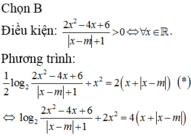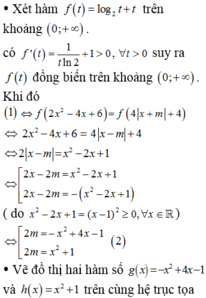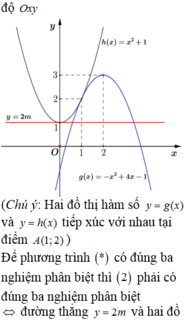

![]()
![]()
![]()
![]()



Hãy nhập câu hỏi của bạn vào đây, nếu là tài khoản VIP, bạn sẽ được ưu tiên trả lời.


![]()
![]()
![]()
![]()




Câu 1:
\(\Leftrightarrow x^2-4x+5+\sqrt{x^2-4x+5}-5=m\)
Đặt \(\sqrt{x^2-4x+5}=\sqrt{\left(x-2\right)^2+1}=a\ge1\)
\(\Rightarrow a^2+a-5=m\) (1)
Xét phương trình: \(x^2-4x+5=a^2\Leftrightarrow x^2-4x+5-a^2=0\)
\(\left\{{}\begin{matrix}x_1+x_2=4\\x_1x_2=5-a^2\end{matrix}\right.\)
\(\Rightarrow\) Nếu \(5-a^2>0\Rightarrow1\le a< \sqrt{5}\) thì pt có 2 nghiệm dương
Nếu \(5-a^2\le0\) \(\Leftrightarrow a\ge\sqrt{5}\) thì pt có 1 nghiệm dương
Vậy để pt đã cho có đúng 2 nghiệm dương thì: (1) có đúng 1 nghiệm thỏa mãn \(1\le a< \sqrt{5}\) hoặc có 2 nghiệm pb \(a_1>a_2\ge\sqrt{5}\)
Xét \(f\left(a\right)=a^2+a-5\) với \(a\ge1\)
\(f'\left(a\right)=0\Rightarrow a=-\frac{1}{2}< 1\Rightarrow f\left(a\right)\) đồng biến \(\forall a\ge1\) \(\Rightarrow y=m\) chỉ có thể cắt \(y=f\left(a\right)\) tại nhiều nhất 1 điểm có hoành độ \(a\ge1\)
\(f\left(1\right)=-3\) ; \(f\left(\sqrt{5}\right)=\sqrt{5}\)
\(\Rightarrow\) Để pt có 2 nghiệm pb đều dương thì \(-3\le m< \sqrt{5}\)
Câu 2:
\(x^2-3x+2\le0\Leftrightarrow1\le x\le2\) (1)
Ta có: \(mx^2+\left(m+1\right)x+m+1\ge0\)
\(\Leftrightarrow m\left(x^2+x+1\right)\ge-x-1\)
\(\Leftrightarrow m\ge\frac{-x-1}{x^2+x+1}=f\left(x\right)\) (2)
Để mọi nghiệm của (1) là nghiệm của (2) \(\Leftrightarrow\left(2\right)\) đúng với mọi \(x\in\left[1;2\right]\)
\(\Rightarrow m\ge\max\limits_{\left[1;2\right]}f\left(x\right)\)
\(f'\left(x\right)=\frac{-\left(x^2+x+1\right)+\left(2x+1\right)\left(x+1\right)}{\left(x^2+x+1\right)^2}=\frac{x^2+2x}{\left(x^2+x+1\right)^2}>0\) \(\forall x\in\left[1;2\right]\)
\(\Rightarrow f\left(x\right)\) đồng biến \(\Rightarrow\max\limits_{\left[1;2\right]}f\left(x\right)=f\left(2\right)=-\frac{3}{7}\)
\(\Rightarrow m\ge-\frac{3}{7}\)

Đặt \(log_2\left(\frac{8x-2^x-12m}{3}\right)=t\)
\(\Rightarrow8x-2^x-12m=3.2^t\)
Ta được hệ: \(\left\{{}\begin{matrix}3t-2^x-x=3m\\8x-2^x-3.2^t=12m\end{matrix}\right.\)
\(\Leftrightarrow\left\{{}\begin{matrix}12t-4.2^x-4x=12m\\8x-2^x-3.2^t=12m\end{matrix}\right.\)
\(\Rightarrow12t-3.2^x-12x+3.2^t=0\)
\(\Leftrightarrow3.2^t+12t=3.2^x+12x\)
Hàm \(f\left(a\right)=3.2^a+12a\) đồng biến trên R nên đẳng thức xảy ra khi và chỉ khi \(x=t\)
\(\Rightarrow3x-2^x-x=3m\)
\(\Leftrightarrow2x-2^x=3m\)
Khảo sát hàm \(f\left(x\right)=2x-2^x\Rightarrow f'\left(x\right)=2-2^x.ln2=0\)
\(\Rightarrow2^x=\frac{2}{ln2}\Rightarrow x=log_2\left(\frac{2}{ln2}\right)=1-log_2\left(ln2\right)\)
Từ BBT ta thấy để pt có đúng 2 nghiệm thực pb
\(\Leftrightarrow3m< f\left(1-log_2\left(ln2\right)\right)\Rightarrow m\le0\) do m nguyên
Có 20 giá trị nguyên của m

Phương trình hoành độ giao điểm của đồ thị và đường thẳng là \(-x+m=\frac{x^2-1}{x}\)
\(\Leftrightarrow2x^2-mx-1=0\) (*) (vì x = 0 không là nghiệm của (*))
Vì ac < 0 nên phương trình (*) luôn có 2 nghiệm phân biệt khác không
Do đó đồ thị và đường thẳng luôn cắt nhau tại hai điểm phân biệt :
\(A\left(x_1;-x_1+m\right);B\left(x_2;-x_2+m\right)\)
\(AB=4\Leftrightarrow\sqrt{\left(x_2-x_1\right)^2+\left(-x_2+m+x_1+m\right)^2}=4\)
\(\Leftrightarrow2\left(x_2-x_1\right)^2=16\)
\(\Leftrightarrow\left(x_2+x_1\right)^2-4x_2x_1=8\)
Áp ụng định lý Viet ta có : \(\begin{cases}x_2+x_1=\frac{m}{2}\\x_2x_1=-\frac{1}{2}\end{cases}\)
\(AB=4\Leftrightarrow\frac{m^2}{4}+2=8\Leftrightarrow m=\pm2\sqrt{6}\)
Vậy \(m=\pm2\sqrt{6}\) là giá trị cần tìm

\(log\left(5\left(x^2+1\right)\right)\ge log\left(mx^2+4x+m\right)\)
- BPT đúng \(\forall x\Rightarrow log\left(mx^2+4x+m\right)\) xác định \(\forall x\in R\)
\(\Rightarrow mx^2+4x+m>0\) \(\forall x\in R\)
\(\Rightarrow\left\{{}\begin{matrix}a=m>0\\\Delta'=4-m^2< 0\end{matrix}\right.\) \(\Rightarrow m>2\) (1)
- Lại có \(x^2+1\ge1\) \(\forall x\)
\(\Rightarrow5\left(x^2+1\right)\ge mx^2+4x+m\)
\(\Leftrightarrow5\left(x^2+1\right)-4x\ge m\left(x^2+1\right)\)
\(\Leftrightarrow5-\dfrac{4x}{x^2+1}\ge m\)
Đặt \(f\left(x\right)=5-\dfrac{4x}{x^2+1}\Rightarrow f\left(x\right)\ge m\) \(\forall x\Leftrightarrow m\le min\left(f\left(x\right)\right)\)
Ta có \(f\left(x\right)=3+2-\dfrac{4x}{x^2+1}=3+\dfrac{2\left(x-1\right)^2}{x^2+1}\ge3\)
\(\Rightarrow min\left(f\left(x\right)\right)=3\Rightarrow m\le3\) (2)
Kết hợp (1), (2) \(\Rightarrow2< m\le3\Rightarrow m=3\)
Vậy có 1 giá trị nguyên duy nhất của m để BPT đúng với mọi x
Đáp án B

1.
Xét \(x^2-mx+m=0\) (1)
\(\Delta=m^2-4m\)
Hàm có đúng 1 tiệm cận đứng khi:
TH1: \(\Delta=0\Leftrightarrow\left[{}\begin{matrix}m=0\\m=4\end{matrix}\right.\)
Th2: (1) có 1 nghiệm \(x=1\)
\(\Leftrightarrow1-m+m=0\left(ktm\right)\)
Vậy \(m\in\left\{0;4\right\}\)
2.
\(\Leftrightarrow m=\frac{x^3+x^2+x}{\left(x^2+1\right)^2}\)
Xét hàm \(f\left(x\right)=\frac{x^3+x^2+x}{\left(x^2+1\right)^2}\Rightarrow f'\left(x\right)=\frac{\left(1-x\right)\left(x+1\right)^2}{\left(x^2+1\right)^3}\ge0;\forall x\in\left[0;1\right]\)
Hàm đồng biến trên [0;1] \(\Rightarrow f\left(0\right)\le m\le f\left(1\right)\Leftrightarrow0\le m\le\frac{3}{4}\)
3.
\(y'=-2sin2x-4sinx=0\Leftrightarrow sinx=0\)
\(\Rightarrow x=k\pi\)
\(y\left(0\right)=6\) ; \(y\left(\pi\right)=-2\)
\(\Rightarrow M=6\)
4.
\(y'=\frac{-1}{\left(x-1\right)^2}< 0\Rightarrow\) hàm số nghịch biến trên các khoảng \(\left(-\infty;1\right)\) và \(\left(1;+\infty\right)\)
5.
\(y'=\frac{-m\left(m-1\right)+2}{\left(sinx-m\right)^2}.cosx< 0\Leftrightarrow-m^2+m+2< 0\)
\(\Leftrightarrow m\in\left(-\infty;-1\right)\cup\left(2;+\infty\right)\)

3.
\(y'=-3x^2-6x=0\Rightarrow\left[{}\begin{matrix}x=-2\\x=0\end{matrix}\right.\)
\(y\left(-1\right)=m-2\) ; \(y\left(1\right)=m-4\)
\(\Rightarrow y_{min}=y\left(1\right)=m-4\)
\(\Rightarrow m-4=0\Rightarrow m=4\)
4.
Hàm đã cho bậc nhất trên bậc nhất nên đơn điệu trên mọi khoảng xác định
\(\Rightarrow y_{min}+y_{max}=y\left(1\right)+y\left(2\right)=\frac{m+1}{2}+\frac{m+2}{3}=8\)
\(\Rightarrow m=\frac{41}{5}\)
Đáp án B
1.
\(y'=\frac{1}{\left(sinx+1\right)^2}.cosx>0\Rightarrow y\) đồng biến
\(m=y_{min}=y\left(0\right)=2\)
\(M=y_{max}=y\left(1\right)=\frac{5}{2}\)
\(\Rightarrow M^2+m^2=\frac{41}{4}\)
2.
Hàm xác định trên \(\left[-2;2\right]\)
\(y'=1-\frac{x}{\sqrt{4-x^2}}=0\Leftrightarrow x=\sqrt{2}\)
\(y\left(-2\right)=-2\) ; \(y\left(\sqrt{2}\right)=2\sqrt{2}\) ; \(y\left(2\right)=2\)
\(\Rightarrow N=-2;M=2\sqrt{2}\)
\(\Rightarrow M+2N=2\sqrt{2}-4\)